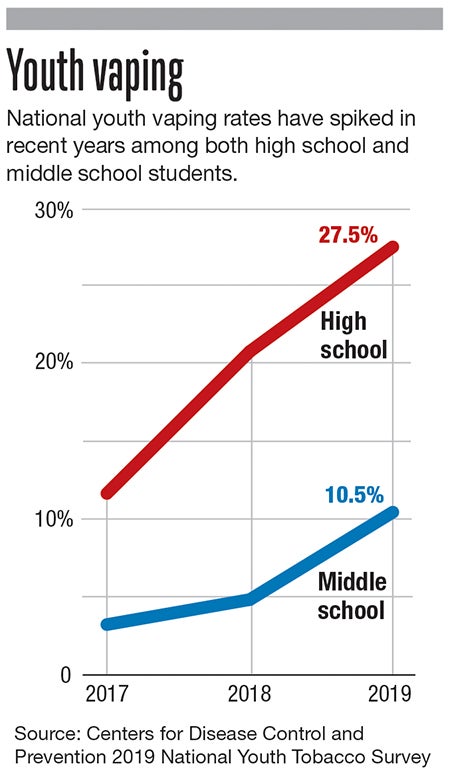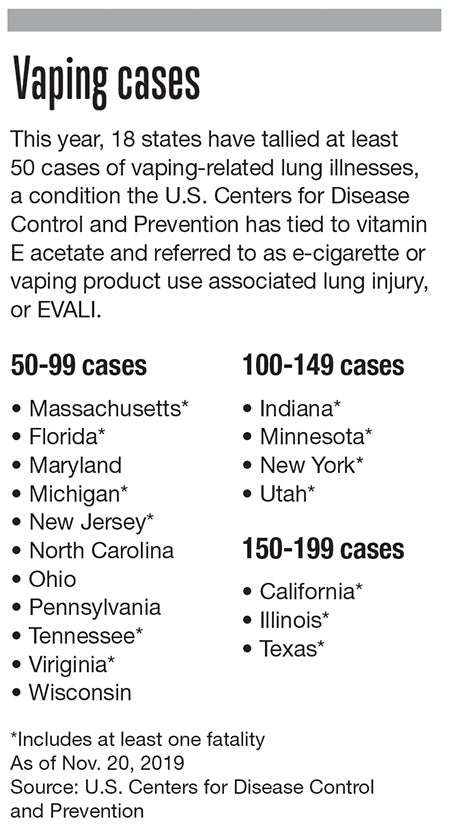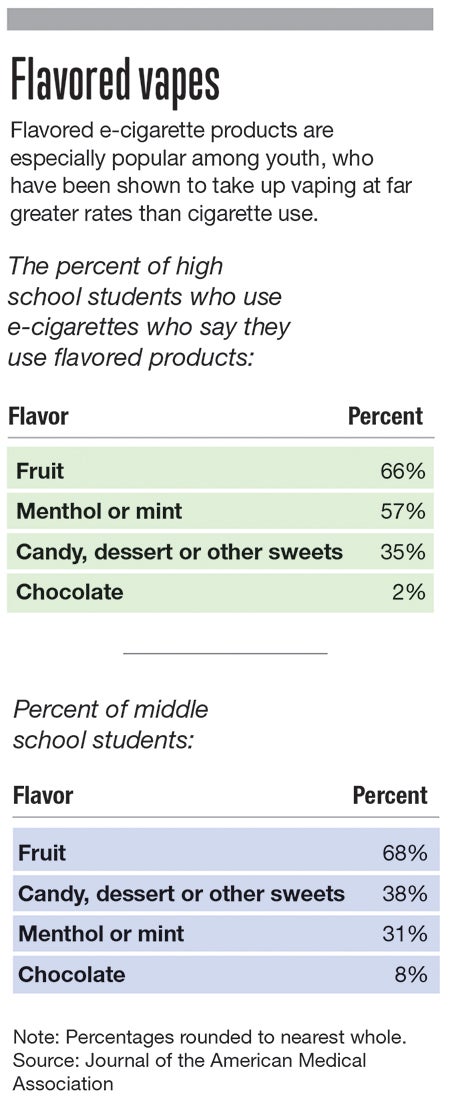This year has been turbulent for the vaping industry nationwide: more than 2,000 have been sickened with a lung illness traced to vaping, and 42 have died.
Get Instant Access to This Article
Subscribe to Worcester Business Journal and get immediate access to all of our subscriber-only content and much more.
- Critical Central Massachusetts business news updated daily.
- Immediate access to all subscriber-only content on our website.
- Bi-weekly print or digital editions of our award-winning publication.
- Special bonus issues like the WBJ Book of Lists.
- Exclusive ticket prize draws for our in-person events.
Click here to purchase a paywall bypass link for this article.
This year has been turbulent for the vaping industry nationwide: more than 2,000 have been sickened with a lung illness traced to vaping, and 42 have died.
In Massachusetts, Gov. Charlie Baker put a four-month ban on vaping products in September. That wasn’t the only first-in-the-country step to take place in the state: the House and Senate have since passed bills banning all flavored tobacco and adding a stiff new tax on e-cigarettes.

Even Juul Labs in San Francisco, the leading maker of e-cigarettes, has stopped selling some of its flavored products, including mint.
Today’s e-cigarette users can go one of two ways if they kick their vaping habit: Turn to cigarettes, which many previously or presently smoke, or give up nicotine altogether.
Health experts are hopeful health dangers associated with e-cigarettes – and the public attention they’ve received – could provide an impetus for smokers to finally give up the habit.
“I would hope that there would be some who were in the process of quitting, going from cigarettes to vaping, who could try another form of nicotine replacement,” said Dr. Jeffrey Scott, a pulmonologist with Worcester physician’s group Reliant Medical Group.
Scott has found optimism in changes like the decision in September by MassHealth, the state’s program for Medicaid and Children’s Health Insurance Program, to eliminate co-payments on products to help people quit smoking, including gum, patches and lozenges.

With the policy change, members have no out-of-pocket costs for products to help them quit smoking, including prescription medications and over-the-counter products including nicotine replacement therapy such as Nicorette, as well as gum, patches, and lozenges. Some medications require a prescription, like Chantix, but also do not require a co-pay.
The Massachusetts Department of Public Health has increased its support for those calling its smokers’ quitting helpline.
After an initial screening and coaching session, smokers looking to quit now receive eight weeks’ supplies of smoking cessation products, twice as long as before. A standing order for nicotine replacement products now allows people to access over-the-counter products including gum and patches as covered through their insurance.
“Any relief of those barriers is potentially very helpful,” Scott said.
Marc Hymovitz, the director of government relations for Massachusetts for the American Center Society’s Cancer Action Network, is among those pushing for legislative changes to push more smokers toward quitting.
“We now know that both products are dangerous,” Hymovitz said of traditional cigarettes and their newer electronic counterparts. “We hope that people will quit but we know that’s very difficult to do.”
Rising popularity
Smoking rates, among both adults and youth, had been on a long and steady downward trend, hitting a record low among adults in 2018, according to the Centers for Disease Control and Prevention.

But e-cigarettes – battery-powered devices heating nicotine similar to lighting a cigarette – have undone much of that progress.
Most worrisome to health officials has been spiking youth rates, with minors far more likely to vape than adults.
Vaping spiked in 2018 among both high school and middle school students, according to a survey released this spring by the U.S. Food and Drug Administration and the CDC. Among high school students, use more than doubled to 27.5% in just two years, and in middle schools, use tripled to 10.5%.
A survey published in November by the Journal of the American Medical Association found high school and middle school students use e-cigarettes more than four times as often as traditional cigarettes.
“With the uptick in e-cigarettes, we started to lose that progress, and kids were hooked,” Hymovitz said.
“It’s surprising but it shouldn’t be,” Hymovitz added of vaping’s popularity, “because the tobacco industry – which owns most of the vaping industry – used the same tactics as they have with e-cigarettes: candy flavors, fruity flavors and cheap prices.”
Dr. Daniyal Siddiqui, a hematologist and oncologist at Saint Vincent Hospital in Worcester, said he’s been shocked at how widespread youth vaping rates have become so quickly.
“They’re just very scary numbers,” he said.
Scott doesn’t believe many users are weaning themselves off cigarettes, as Juul has marketed itself as a sort of smoking cessation product.
“There must be a big percentage of people vaping who never smoked cigarettes,” Scott, whose Reliant office is in Southborough, said of youth vaping rates.
“To have an alternative access point to get addicted,” he said of vaping taking the place of traditional cigarettes, “it’s been a tragedy.”
The CDC says vaping is not safe for kids, teens and young adults, and nicotine can be especially addictive for younger people into their early or mid-20s.
Flavored products – those receiving the most ire of health officials – have been shown in surveys to be largely responsible, making up most of vaping products minors use.
Two thirds of regular e-cigarette users in high school to use fruit flavors, according to the Journal of the American Medical Association study. Nearly as many used mint or menthol flavors.
Another Journal of the American Medical Association study in 2016 found a connection between youth vaping and an eventual use of cigarettes, and a study published in November in the journal Pediatrics found an association between the use of flavored vaping products and higher continued usage of e-cigarettes.
Massachusetts has among the country’s lowest cigarette smoking rates but hasn’t been immune to the rise of vaping. A 2016 report by the CDC said 4.3% of Massachusetts adults vaped, not significantly better than the national median of 4.7%.
An unexpected outbreak
A spate of lung illnesses began this spring but peaked in the summer initially stumped health agencies, which noticed patients were all e-cigarette users but couldn’t immediately trace a cause.

By November, the CDC said it identified vitamin E acetate as a chemical it strongly believed was responsible. But by then, more than 2,000 nationwide had been sickened and more than 40 killed – including a Worcester County man and a Middlesex County woman.
“Lungs are very delicate structures,” Siddiqui, the Saint Vincent Hospital doctor, said. He compared a lung to a filter used in a home or office building that, unlike a lung, could be changed out if it got dirty.
“So we have to take really good care of that filter,” he said. “Anything other than air is going to clog it.”
At the same time the e-cigarette outbreak has spread, new research has come in showing the harm of e-cigarettes to smokers’ health.
A study released in November by the Smidt Heart Institute at Cedars-Senai in Los Angeles showed e-cigarettes to be just as harmful to the heart, if not more so, than traditional cigarettes. Researchers measured blood flow to the heart of cigarette and e-cigarette users and found flow to rebound more quickly among those smoking traditional cigarettes.
Dr. Florian Rader, a senior author of the study, said it isn’t just nicotine making vaping harmful, but what he called an unknown list of manufactured products used to form vapors likely causing the most harm.
A sudden response
Response to the lung illness outbreak and a related public outcry has led to swift action.
Juul stopped selling mango, fruit, creme and cucumber liquid-nicotine pods in brick-and-mortar stores last year and online this September. In early November, Juul said it would stop selling mint-flavored products, which account for 70% of the company’s American sales in light of what it said was youth surveys showing the mint products’ popularity.
In September, Gov. Baker put in place a four-month ban on the sale of vaping products, the first such prohibition in the country – and one that has faced legal challenges since. The state Legislature has taken action, too, voting in November to ban the sale of all flavored tobacco products and tax e-cigarettes at 75%.
Apple said in November it removed 181 vaping apps from its online store because of crackdown by regulators and what it called a public health crisis.
Attorneys general in California, New York and North Carolina have sued Juul for what they say is marketing geared toward youth.
The FDA sent Juul a warning letter in September for what it said was the company illegally marketing its products as safer than traditional cigarettes.

Further action expected from the federal government will not be taking place, however.
The secretary of the U.S. Department of Health and Human Services, Alex Azar, said in September the federal government would soon ban flavored vaping products, citing rising youth usage rates. But by November, the President Donald Trump Administration quietly ended the idea.
Health advocates are still pushing for further change.
The American Medical Association voted Nov. 20 to lobby for the ban of all e-cigarettes at the state and federal levels. The association labeled vaping a public health crisis last year.
Local doctors are urging patients to stick to a plan to quit, knowing how difficult such a task can be.
“I’m always amazed at what a strong addiction nicotine can be. People have said it’s harder to quit nicotine than heroin or alcohol,” Scott said. “My message to patients is always, ‘Be persistent.’ People quit smoking every day, even those who didn’t think they could.”

